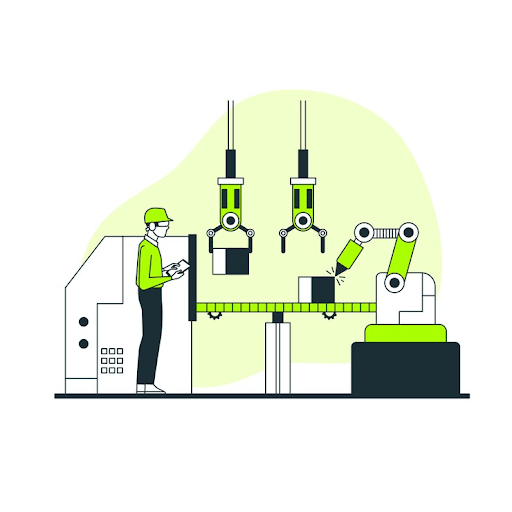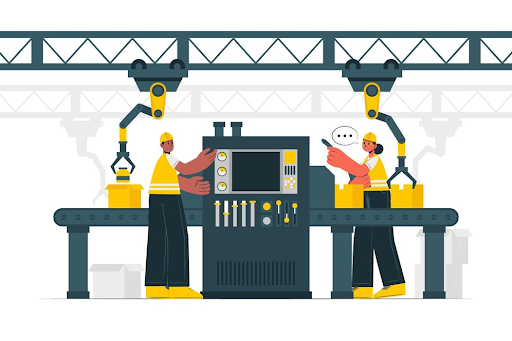
- 1. Predictive Maintenance
- 2. Quality Optimization
- 3. Intelligent Supply Chain Optimization
- 4. Accelerated R&D and Product Innovation
- 5. Conversational AI for Seamless Human-Machine Collaboration
- 6. Key Challenges in Scaling ML for Manufacturing
- 7. Conclusion: The Machine Learning Manufacturing Revolution Has Begun
The manufacturing industry is rapidly adopting machine learning (ML) to drive efficiency, quality, and innovation. By 2030, applications of machine learning in manufacturing are predicted to create $8,776.7 million in value as organizations leverage predictive insights to optimize production, supply chains, and product design. This article explores the top machine learning use cases in manufacturing that will deliver transformative value in the sector over the next few years.
Predictive Maintenance
Predictive maintenance will be one of the most widely deployed machine learning manufacturing use cases by 2024. ML algorithms analyze sensor data from equipment and predict potential failures before they occur. This prevents unplanned downtime and optimizes maintenance planning.
Key applications include:
Detecting Anomalies in Vibration, Temperature and Other Metrics
By applying machine learning and manufacturing software development services to sensor metrics like vibration and temperature, manufacturers can identify anomalies indicative of a developing fault. Addressing these early prevents catastrophic failures.
Predicting Machine Component Failure
Machine learning for manufacturing analyzes telemetry, usage data, and maintenance logs to forecast the remaining useful life of components like motors and bearings, enabling just-in-time maintenance.
Optimizing Maintenance Schedules
Algorithms analyze past maintenance activities and equipment telemetry to determine optimal replacement frequencies for parts. This minimizes over or under-maintenance.
Quality Optimization
ML will be instrumental in manufacturers' optimizing product quality in 2024. Algorithms perform tasks like visual quality inspection, predictive quality modeling and optimization of QA testing procedures.
Key use cases include:
Automated Visual Inspection
Historical process parameters and machine telemetry data are analyzed using ML in manufacturing examples, enabling predictions of quality issues and root causes.
Predictive Quality Modeling
By analyzing historical process parameters, testing data, machine sensor telemetry and finished product quality metrics, ML models can predict potential quality issues and their root causes. This allows preventative adjustments.
Optimization of Quality Assurance Testing
Algorithms can determine which products truly require extensive quality testing versus a small sample. ML can also optimize the types and frequency of different quality tests required based on historical data correlations. This reduces quality testing overhead.
Intelligent Supply Chain Optimization
Manufacturing and machine learning work hand-in-hand to unlock granular visibility across global supply chains in 2024. Manufacturers leverage AI to predict delays, optimize inventory and shipping, and digitally twin the entire supply network.
Key applications include:
Demand Forecasting and Inventory Optimization
By analyzing various data sources, machine learning in manufacturing generates accurate demand forecasts, optimizing inventory planning. This optimizes inventory planning to balance availability and working capital requirements.
Production Planning and Scheduling
Leveraging demand insights, ML models sequence production runs, adjust staffing, and schedule deliveries to optimize efficiency and on-time delivery rates. Reinforcement learning allows systems to improve scheduling continuously.
Supply Chain Network Optimization
Algorithms analyze supply and demand data across the extended supply chain to optimize material flows. This includes optimizing logistics routes and transportation modes to minimize costs and environmental impact.
Accelerated R&D and Product Innovation
Machine learning in manufacturing examples unlock game-changing opportunities for manufacturers to accelerate new product development, reduce costs, and integrate customer preferences in 2024.
Key applications include:
ML-Assisted Design
Algorithms trawl historical design data, simulations, past testing results and customer preferences to provide design recommendations, optimized parameters and reliability insights to engineers. This reduces development cycles.
Autonomous Experimentation
Robotic process automation and ML analyze historical data to develop simulation parameters automatically, run simulations, adjust parameters, identify optimal designs, and even physically test the most promising options.
Embedding Customer Preferences
By analyzing user reviews, survey data, focus group results, and even social media patterns, ML models quantify customer preferences and pain points. This allows manufacturers to integrate “voice-of-the-customer” insights directly into product development.
Conversational AI for Seamless Human-Machine Collaboration
A key theme across all these manufacturing machine learning use cases will be closer integration between human talent, algorithms, robots and business systems. Conversational AI and natural language interfaces will play a key role in enabling seamless collaboration.
By 2024, manufacturers will deploy conversational agents using technologies like chatbots, voice assistants and multi-modal interfaces powered by natural language processing (NLP) capabilities. These will enable more intuitive human-machine coordination for activities like:
Technicians accessing predictive maintenance insights from ML models
Engineers querying design recommendations from autonomous R&D assistants
Supply chain analysts discussing inventory optimization recommendations with digital twins
Factory workers getting assembly instructions from computer vision-enabled smart glasses
This human-in-the-loop approach will be critical for scaling ML while keeping humans firmly in control. User trust, transparency, and explainability will be crucial.
As conversational AI in manufacturing matures, organizations will implement frameworks like the “Five C’s” – clean, consistent, conformed, current, and comprehensive – to ensure human-machine collaboration aligns with ethical principles.
Key Challenges in Scaling ML for Manufacturing

Despite these possibilities, there are challenges involved in implementing and enlarging machine learning manufacturing applications. Some key challenges include:
Lack of High-Quality Structured Data
A vast number of manufacturers have no sensors, enterprise integration, data governance, and quality standards to support ML. Substantial initial costs are required to gather and organize the pertinent data that are so vital.
Cultural Resistance
The personnel and cultural change needed for effective ML are often overlooked. Insufficient top management support, skill deficits, and resistance to change from traditional processes also help slow the progress. This is the reason why commitment to reskilling and new ways of working is important.
Bias and Ethics Concerns
Machine learning models that are trained based on poor data collected in the past may carry forward the bias inherent in such data, leading to such things as bias, unethical, or unsafe decisions. Algorithm audits, oversight protocols and human-in-the-loop checks have to be put in place by manufacturers to deal with this.
Cybersecurity and Safety Risks
The growth of network connections and remote control gives cyber threats from ransomware to sabotage by the adversary. Lack of success in ML systems also presents physical safety risks to human workers who are operating the system. Manufacturers have to adopt cybersecurity by design and human oversight of ML.
All these are hurdles that are by no means insurmountable. By combining ML expertise with manufacturing domain knowledge, implementing data governance, and taking an ethical-by-design approach, manufacturers can drive immense value from AI by 2024 and beyond.
Conclusion: The Machine Learning Manufacturing Revolution Has Begun
Machine learning is no longer an emerging technology. The manufacturing ML revolution has already begun. From global auto giants using ML for self-optimizing factories to mom-and-pop machine shops deploying computer vision for product inspection, AI applications are scaling rapidly.
And this is just the beginning. As sensors proliferate, data quality and accessibility improve, and ML solutions become more democratized and configurable, adoption will accelerate. Combined with complementary innovations like IoT, robotics, and 5G, machine learning manufacturing use cases will rapidly expand.
The biggest opportunities and competitive advantages will go to those manufacturers who embrace this transformation early. Now is the time for operations managers, engineers and executives to build partnerships, develop in-house capabilities, and make targeted investments in AI. The potential to drive step-function improvements in efficiency, quality, innovation and sustainability makes this a competitive imperative.
The factory of the future will look very different from today. It will seamlessly integrate human creativity and ML-driven automation. It will virtually eliminate waste and defects through predictive optimization. It will respond in real time to customer needs and external disruptions. And it will unlock new possibilities for designs and business models.
2024 offers a critical window for manufacturers to transform. Organizations that leverage machine learning to enhance processes and innovation during this period will be best positioned to lead in the coming decades. The race for machine learning manufacturing supremacy has begun – are you ready?


